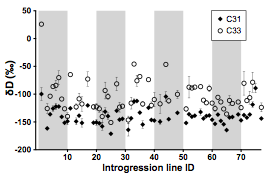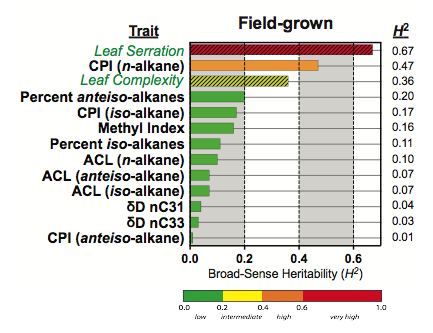Reports: DNI253417-DNI2: Deconvolution of Sources of Isotopic Variability in Higher Plant Biomarkers
Alexander S. Bradley, Washington University in St. Louis
A valuable set of analytical techniques in organic geochemistry relates to the measurement of the isotopic composition of individual hydrocarbons. Plant waxes are one potential source of hydrocarbons, and are largely comprised of long-chain (>C22) alkanes, fatty acids, and alcohols deriving from a variety of terrestrial sources. During Year 1 (2013-2014), we worked to characterize the underlying biological variability of isotopic compositions of plant wax hydrocarbons from plants grown under a relatively controlled set of conditions. In Year 2, we focused on a set of experiments designed to better deconvolute the sources of isotopic variability in plants by quantifying the amount of variability that can be attributed to genetic vs. physiological factors.
In this approach, we examined the isotopic variability among
introgression lines of two closely related species: cultivated tomato ( In Year 1 we conducted a greenhouse study in which we grew
both In Year 2, we conducted a field study in which we grew each
introgression line at a replication of 15. We have analyzed the
deuterium/hydrogen ratio of lipids from all ILs at a replication of four.
Further characterizations involve structural characterizations of the degree of
methylation of leaf wax lipids, and the average chain length. These metrics are
being combined with analyses completed by collaborators characterizing the
phenotypic variations in leaf shape, root morphology, and leaf metallomes in these introgression lines .
We are primarily interested in quantifying the degree to
which variation in plant-related phenotypes that are used as paleoclimate
proxies (d13C, dD, average chain length) can be ascribed
to genetic (biological) versus environmental variation. Geochemists commonly
use these metrics in a purely climatological sense, and implicitly assume that
the variability attributable to biology is near zero. In order to quantify this
implicty assumption we have used characterizations of
broad-sense heritability ( which is the proportion of the phenotypic variance that can
be attributed to the sum of all genetic contributions to the phenotypic
variance (i.e. excluding the phenotypic variance that can be attributed to
environmental factors). A broad sense heritability of greater than 0.6 is
considered very high, while values of Our preliminary results suggest that attributes of leaf
waxes have relatively low heritabilites. While some
traits such as carbon preference index (CPI, Broadly speaking, this is an encouraging result with regard
to the applicability of alkanes as recorders of paleoclimate variability, as
they suggest that at least in this group of organisms, genetic factors do not
strongly encode the variations in leaf wax metrics that might be observed in
sediments. In contrast, these proxies are only weakly heritable, leaving open
the possibility that environmental parameters such as hydrological regime and
average growth temperature play a strong modulating role in encoding them.


![]()













